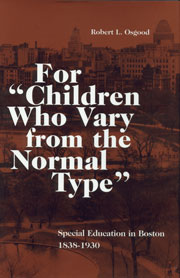Special Education in Boston, 1838 - 1930
Robert L. Osgood
|
Read chapter four. Read a review. |
$61.00s print edition $41.00 e-book |
From Disability Studies Quarterly
In this study of special education in the United States, Osgood discusses the school system in Boston during the period from 1838-1930 as his spatial and chronological reference points, arguing that the Boston school system is a representative microcsom of the American school system. These decades witnessed dramatic change in social and scientific outlook. The book is in two parts.
Part I is a concise overview of education in genral in Boston; the bulk of the book, Part II, traces the development of Boston’s special education programs. Osgood organized the material topically rather than chronologically, e.g., Chapter Six discusses the Horace Mann School for the Deaf, while Chpater Seven is titled “Disciplinary Programs for the Boston Schools.” Osgood frames the topic of special education in light of the prennial question of the degree to which disabled children should be fully integrated with their nondisabled peers.
For “Children Who Vary from the Normal Type” is a solid historical inquiry. It is well conceived, thoroughly researched, and clearly written. There is a nice balance of primary and secondary material. Quotes from various administrators, for example, enliven and clarify, but do not overwhelm the work. Appropriate black and white photographs, along with clean charts, illustrate the text effectively. The greatest strength of the work is Osgood’s command of the complex layers of historical context including the intertwined issues of eugenics, immigration, and mental teasing. He is able to analyze, yet leave intact, the perspective of the mid-Nineteenth through mid-Twentieth Century. There was, for example, little differentiation between children with discipline problems and children with mental retardation during the time period. Where the evidence is missing, he makes intelligent surmises, but he never pushes conclusions beyond what the evidence will bear. The book ends with guarded optimism for the potential of full integration.
The weaknesses of the book concern production rather than content. The notes to each chapter are grouped at the back of the book making for cumbersome reading. Worse, ther is no separate bibliography. These are minor complaints. Historians, education professionals, and scholars of Disability Studies will benefit from reading this fine historical study.
Robert L. Osgood is chair of Teacher Education and professor of Education at St. Norbert College.
Print Edition: ISBN 978-1-56368-089-2, 6 x 9 hardcover, 220 pages, photographs, notes, references, tables, index
$61.00s
E-Book: ISBN 978-1-56368-216-2
$41.00
To order by mail, print our Order Form or call:TEL 1-800-621-2736; (773) 568-1550 8 am - 5 pm CST
TTY 1-888-630-9347
FAX 1-800-621-8476; (773) 660-2235
